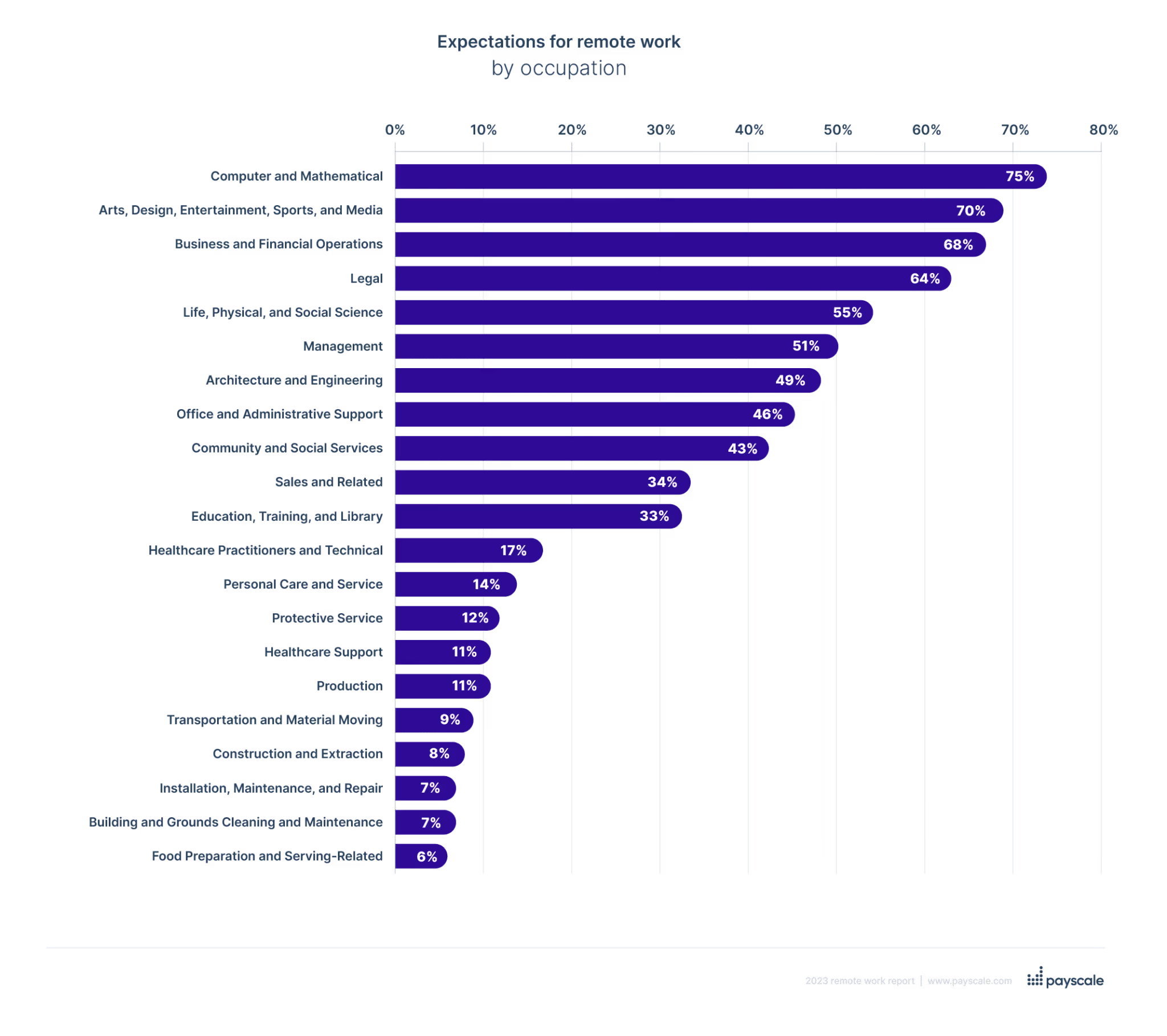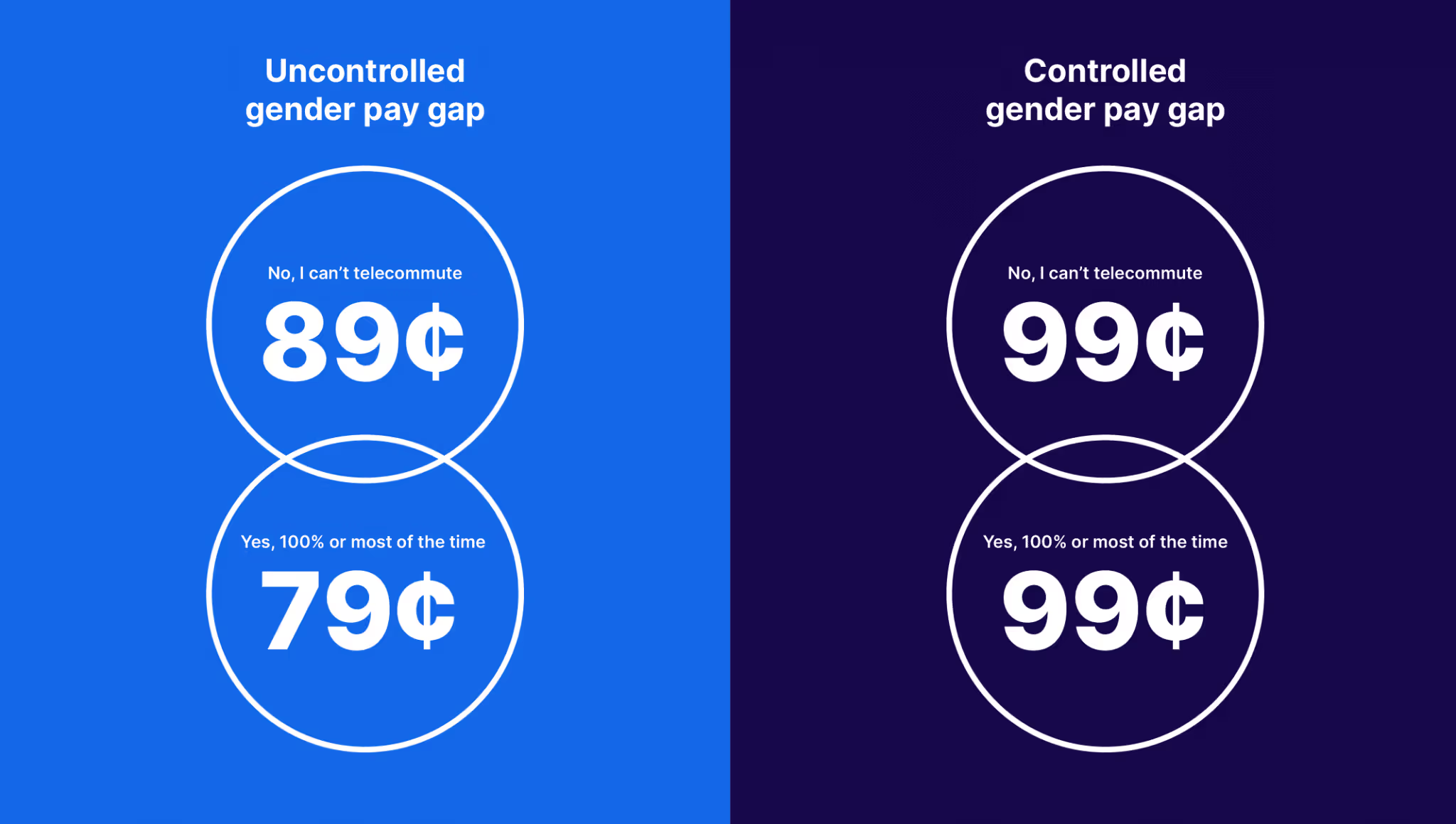Introduction
Remote work has been a hot topic since the COVID-19 pandemic forced a significant number of employees to work from home (WFH) in 2020. Now, three years later, it appears that employees don’t want to come back, despite mandates from some prominent organizations to return to offices or risk termination.
Although most employers (91 percent) acknowledge the importance of offering increased workplace flexibility to attract and retain talent, giving employees autonomy in where and how to work is being revoked due to the negative impact remote work is perceived to have on productivity, culture and connection, training new workers, and other concerns.
Meanwhile, employees insist they are productive from home and are resisting return-to-office mandates or outright quitting to retain workplace flexibility. Research studies from a variety of accredited institutions have shown mixed results on the impact of remote work on productivity, with some studies claiming that employees in hybrid work environments are the most productive and other studies challenging those findings.
In this report, Payscale examines the state of remote work and return-to-office mandates in 2023 with an emphasis on how these affect compensation management. Since the pandemic, have employee expectations around the continuation of remote work opportunities changed? What impact does remote work have on salaries, and is it worse for women who work from home? To what degree does the inability to work from home impact attrition?
This report answers these questions using Payscale’s employee-sourced data from our online salary survey, which analyzes 309,971 responses collected between August 2021 and August 2023. In addition, we surveyed 980 employers on their remote-work policies and pay practices from July–August of 2023. Highlights from the employer survey are included on this page. The complete analysis is available for download to help inform executives, HR leaders, and compensation professionals on how other organizations are responding to these challenges.
Employees expect remote work to continue
In our online survey, we asked respondents: “Following work-from-home ordinances in 2020, have your expectations for remote work in your occupational field changed?” Overall, a sizable portion of the population (47 percent) say they continue to expect more organizations to offer remote work in their field after the pandemic ends. This has only increased since 2020. The other 53 percent have not changed their expectations. Zero percent expect fewer employers to offer remote work options in their field.

The percentage fluctuates widely by occupation, which should not be surprising. For Computer & Mathematical occupations, expectations for remote work to continue is 75 percent. For Arts, Design, Entertainment, Sports, & Media occupations, it is 70 percent. For Business & Financial Operations occupations, it is 68 percent. These are all jobs that can more easily be done from home. Conversely, for Building & Grounds Cleaning and Maintenance occupations, as well as Installation, Maintenance, & Repair occupations, it is only 7 percent. For Construction & Extraction occupations, it is only 8 percent.

We also looked at responses by gender. Women, who tend to bear more of the burden when it comes to childcare and domestic responsibilities, have slightly higher expectations for remote work opportunities than men, at 48 percent compared to 43 percent.


The percentage of remote workers has grown
The expectations for remote work opportunities to continue are validated by the fact that the percentage of employees who work from home is increasing.
In our online survey, we asked participants for their work-from-home status. Overall, 44 percent of respondents say they cannot work from home at all, while 28 percent say they can work from home either all the time or most of the time.

In looking at this data over time, we can see a sharp increase in the percentage of people who can work from home/telecommute all or most of the time since the COVID-19 pandemic began in 2020. However, it has continued to increase in subsequent years, even as return-to-office mandates began in 2022.
Correspondingly, the median pay for employees who work from home has skyrocketed alongside remote-work status. In 2015, the median pay for remote workers was $57,100 when only 7 percent of people worked from home all or most of the time. In 2020, during the beginning of the pandemic, the median pay for remote workers was $62,900 when 13 percent of people worked from home. In 2023, the median pay was $78,200 when 28 percent of people worked from home. This is an indication of people in more highly paid occupations now working from home rather than remote workers receiving steep pay increases, as well as higher-than-average wage growth during the Great Resignation.
Mandating a return to the office risks losing higher-paid employees
Remote-work status varies by occupational group, as does median pay. In segmenting the data, we find that occupational groups who work from home in larger numbers correspond to those who expect remote work opportunities to increase. These include computer-related occupations, business and finance professionals, and people in the arts, entertainment, sports, and media.
Median pay varies by job and by industry. When we compare pay between remote workers and non-remote workers within the same occupational group or industry, we find that people who work from home all or most of the time tend to make more than people who work on site. These pay gaps do not signify discrimination. Such pay discrepancies show that organizations with return-to-office mandates stand to risk losing (through termination or attrition) their more highly paid employees, who are often more experienced and uniquely skilled. These employees will be more expensive and difficult to replace.
The pay gaps between remote and non-remote workers are highest in the Retail & Customer Service industry, followed by Finance & Insurance, with Technology companies and Agencies & Consultancies a close third and fourth. Within occupational groups, pay gaps between remote and non-remote workers are highest for Sales and Legal.
The gender pay gap widens for women who work from home
We also examined the gap in median pay between women who work from home versus men who work from home compared to the pay gaps between men and women who cannot telecommute. While there is a pay gap for women compared to men regardless of their work-from-home status, it is significantly wider for women who work from home all or most of the time.
This is the uncontrolled pay gap, which does not measure pay for men and women doing the same jobs and is not a reflection of unequal pay for equal work. Rather, this shows that men occupy higher-paying jobs compared to women, including when they work from home. The data suggests that women face challenges getting higher-paying jobs with workplace flexibility or are paid less for their workplace flexibility than men who also work from home.

Autonomy to choose when to work from home is most correlated with retention
In addition to asking about remote work status, Payscale’s online salary survey also asks participants if they are seeking a new job in the next six months. Through logistic regression analysis, we can correlate intent to leave with remote work status.
We found that people who cannot work from home are 14 percent more likely to seek a new job compared to people who work from home all the time. Conversely, people who work from home all the time are 13 percent less likely to leave than people who cannot work from home.
However, those who can work remotely as needed are the least likely to leave their jobs. They are 32 percent less likely to leave their jobs compared to non-remote workers. This may be a factor of autonomy, suggesting that control over one’s day-to-day working environment is a strong variable in retaining workers.
In fact, we find that intent to leave a job is higher among those who work remotely full-time compared to those who work partially remote. This supports the notion that in-office environments may foster work cultures and relationships that strengthen retention, but only when balanced with the ability to work from home to some degree. The results suggest that being either fully remote or fully in-office are both less effective for retaining workers compared to hybrid working environments.
HR leaders understand the importance of remote work
In 2023, the news has been replete with return-to-office mandates. Prominent organizations like X (Twitter), Meta, Amazon, and Zoom are making headlines by ordering employees back to the office at least a few days a week, or they may risk termination. However, the news has also reported that the rate of attrition in reaction to return-to-office mandates has been greater than executive leadership predicted.
Payscale surveyed HR leaders, compensation professionals, and executives to understand how employers view remote work, return-to-office policies, and geographic compensation strategies beyond these prominently profiled organizations. Of the participants who took our employer survey:

As part of our survey, we asked employers about their current office environment. For organizations that are in-office, hybrid, or where remote work is split by job type (83 percent), we asked them to provide the top reasons for why they require at least some employees to be in the office at least some of the time. The top reason cited is building or maintaining culture or connection, followed by facilitating collaboration. While both are important, the question becomes whether four walls and a water cooler are instrumental in building culture and facilitating collaboration.

We also asked organizations that said they are either remote-first (employees choose whether to come into an office) or fully remote (the organization does not have offices), which is 18 percent of organizations surveyed, for the top reasons driving their remote-work talent strategy.
The top reason cited was a broadened talent pool, meaning the ability to hire talent from anywhere. The second most popular reason was that remote work is a differentiating benefit to help attract and retain talent. These reasons are two sides of the same coin, benefiting the organization and employees, respectively. Third on the list was cost savings from commercial real estate or office equipment. The fourth reason was mental health, which is related to remote work as a differentiating benefit. Increased productivity was a distant fifth.

Remote work is not to blame for the decline in U.S. productivity
News reports have focused on productivity as the primary reason that executives have been driving employees to return to offices, because data from the U.S. Bureau of Labor Statistics has shown that productivity decreased for five straight quarters. While some executives may attribute the fall in productivity to remote work, in our survey, remote work ranked second to last among reasons that could explain the decline in productivity, just behind anti-work sentiment.
The winning reasons are higher-than-average turnover and insufficient pay. These concepts are related. Insufficient pay and high inflation impacted quits rates, which increased to dizzying levels during the Great Resignation. High turnover can impact productivity for years, as it takes time to rehire and retrain talent. Employee engagement also suffers when employees feel stressed and overburdened, which also impacts productivity. This is why people leadership and talent strategy need to be central to business operations.

In our survey to employers, we asked if they measure productivity and how productivity is rewarded if so. While 57 percent of organizations say they measure productivity, only 10 percent say that productivity is highly quantifiable. When it comes to rewards, only 40 percent of organizations say they reward increased productivity and 30 percent of those only do so in a nebulous way that is left up to the manager’s discretion. Finally, while 84 percent of organizations say their executive leadership trusts employees to work from home, at least for select employees, 24 percent say that their executive leadership believes that remote work would decrease productivity.

Geographic pay strategies are on the rise
As more organizations embrace the benefits of offering remote work opportunities to employees and job candidates on a continuing basis in a post-pandemic world, there is a corresponding need to evolve pay management practices to support geographic-based pay.
According to our survey, most organizations (86 percent) have not dramatically changed their pay methodology because of remote work — at least not yet. However, most organizations are continuing to hire employees within a commutable distance to the office. Unsurprisingly, more remote-first (20 percent) and fully remote organizations (23 percent) have changed their methodology than traditional or hybrid organizations.
The type of methodology used to manage pay for employees varies across organizations, with different strategic practices to differentiate pay that depend on company size, industry, workplace environment, distribution of employees, and talent strategy. Almost a third (30 percent) of organizations continue to pay employees according to the location of their headquarters regardless of the employee’s location, which is a marked shift down from before the pandemic, when 37 percent of organizations structured pay this way.
The shift toward some kind of geographic pay strategy which factors in the employee’s location is more prominent for U.S.-based organizations, larger organizations, more geographically distributed or global organizations, remote-first or fully remote organizations, organizations in the technology industry, and organizations paying employees in hyper-competitive markets such as New York, Washington, D.C., or Silicon Valley.
A more detailed breakdown of geographic pay strategies is available to employers in our downloadable whitepaper and is supported by compensation software and services from Payscale.

Methodology
Payscale analyzed 309,971 respondents from our Online Salary Survey between August 2021 and August 2023 that answered the following questions. Respondents also reported occupational and demographic information.
For questions or interviews, please reach out to us through press@payscale.com.
Download the whitepaper
Download our whitepaper to get the results from our employer survey on remote work and return-to-office mandates and learn what HR leaders, compensation professionals, and executives think about the impact of remote work on talent strategy, as well as what pay strategies are most popular for managing remote employees.


